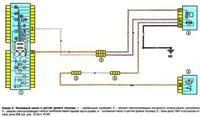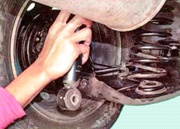On a Renault Logan car, the interior heating and ventilation system is controlled independently from the air conditioning system when performing the function of heating and ventilating the interior, removing frost and condensed moisture from the windshield, as well as blowing the door windows
At the same time, the main elements of the heater also work when the air conditioner is turned on
Heater units and air conditioner evaporator heat exchanger are made in one block.
The main components of the heater:
- - heater heat exchanger (radiator), designed to heat the air entering the passenger compartment with the heat of the engine cooling fluid;
- - an electrically driven fan (supercharger) that provides an adjustable supply of outside air to the dampers of the heater and air conditioner;
- - damper for the temperature regulator of the air coming from the heater to the passenger compartment, the amount of air passing through the heater heat exchanger and outside air passing through the heat exchanger depends on the change in its position;
- - dampers for distributing air from the heater through air ducts to the passenger compartment or for blowing the windshield.
The air conditioning system includes the following elements
Compressor
Compressor belt driven by engine crankshaft pulley.
A friction electromagnetic clutch is built into the compressor pulley, which disconnects the compressor shaft from the pulley or connects them when the air conditioner is operating at the signal of the electronic engine control unit.
During operation, the compressor compresses the refrigerant vapor coming to it from the evaporator heat exchanger to high pressure.
The temperature of the refrigerant vapor at the compressor outlet is much higher than at the inlet.
Reducing valve is built into the compressor and performs a protective function, triggering when the pressure rises above the allowable value at the compressor outlet.
The reason for the pressure reducing valve to trip may be a failure of the high pressure valve, electric fan, etc.
Heat exchanger (radiator) of the condenser, located behind the radiator of the engine cooling system and having a coil with developed fins for rapid cooling and condensation of the refrigerant vapor compressed by the compressor to high pressure.
The throttle branch pipe (reducer) with mesh filters at the inlet and outlet is installed in the pipeline supplying liquid refrigerant to the evaporator heat exchanger.
A throttling hole in the nozzle limits the flow of liquid refrigerant and reduces the pressure in the evaporator.
After the engine stops, the liquid refrigerant continues to flow through the throttle pipe from the high pressure zone to the low pressure zone for some time.
The flow of liquid through the throttle hole is accompanied by a characteristic hissing sound, which is heard for 30-60 seconds after the engine stops and does not indicate a malfunction.
Evaporator heat exchanger (radiator)
The liquid refrigerant from the condenser heat exchanger enters through the throttle pipe into the evaporator heat exchanger located in the heater unit.
In the heat exchanger, the liquid passes into a gaseous state, absorbing heat. The moisture contained in the air entering the heat exchanger condenses on it, flows off the evaporator and is removed from the heater unit.
From the evaporator heat exchanger, the gaseous refrigerant mixed with a small amount of the liquid refrigerant fraction and drops of refrigerant oil enters the receiver, which is connected to the evaporator outlet pipe.
Receiver dryer
In the lower part of the receiver housing there is a container with a water vapor absorber from refrigerant vapors, which, being freed from moisture through a special hole in the intake tube, mix with refrigerant oil.
In the upper part of the receiver housing there are fittings for connecting pipelines.
The receiver is not repairable, it needs to be replaced only as an assembly.
In addition to the listed elements, the system includes high and low pressure valves and pressure sensors.
Principal diagram of the movement of coolant agent in the air conditioning system is shown in fig. 2.
All work on the repair of the air conditioning system should only be carried out with a completely discharged system.
Because refrigerant fumes are toxic, repair the system using the special equipment available from specialized air conditioning services.













